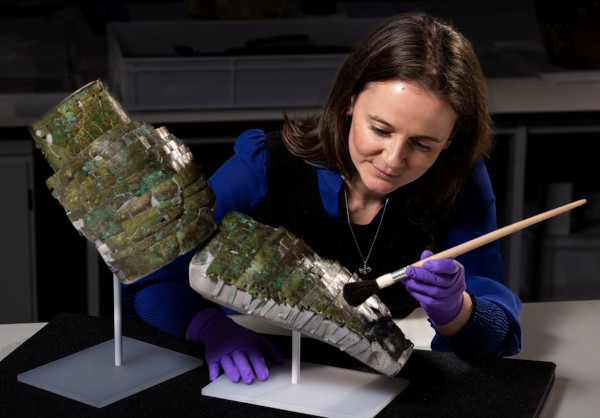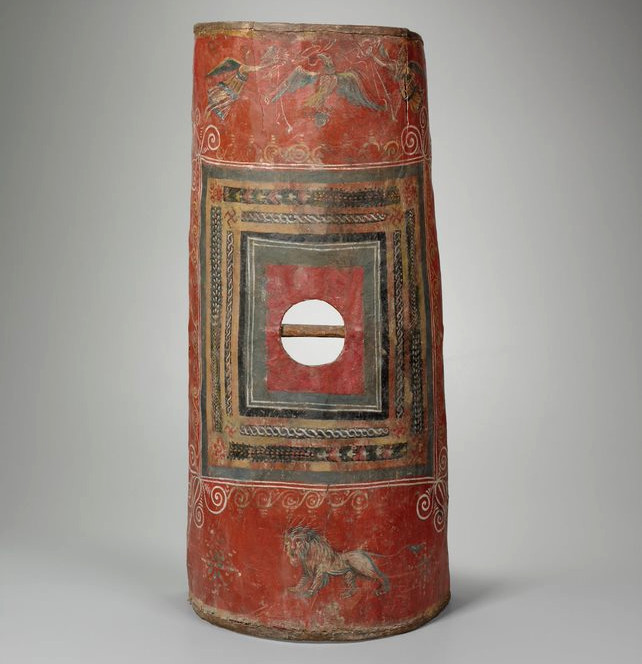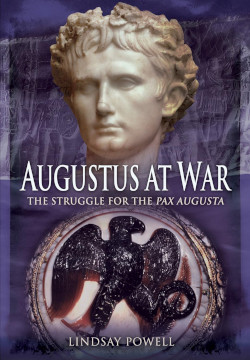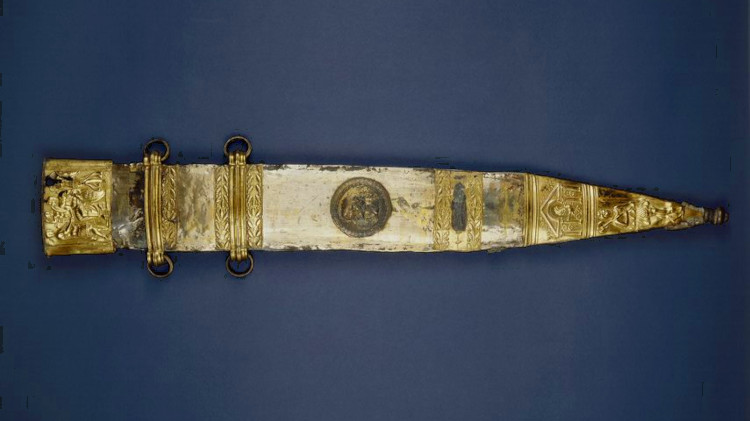
Legion: life in the Roman army is the British Museum’s latest big exhibition. The historian Lindsay Powell reviews it for Historia and finds it “has seemingly achieved the remarkable and the impossible.”
The Romans knew that their way of war was special. Their legendary legion was different from forms of military unit deployed by other nations, and it gave them a competitive advantage on the battlefield.
Remarkably the same legion was key to how the Romans pacified territories they conquered. How could an organization designed for war ever be effective as a force for peace? What was it like to serve ‘with the eagles’? And what about their wives and children?
These themes are explored in a special exhibition at the British Museum, the latest in a now long line of topical expositions for which the institution has rightly become famous. Legion: life in the Roman army brings together over 200 objects, including loans from 28 lenders, from national and international institutions as well as material from its own extensive collection in London. In doing so, the British Museum has seemingly achieved the remarkable and the impossible.
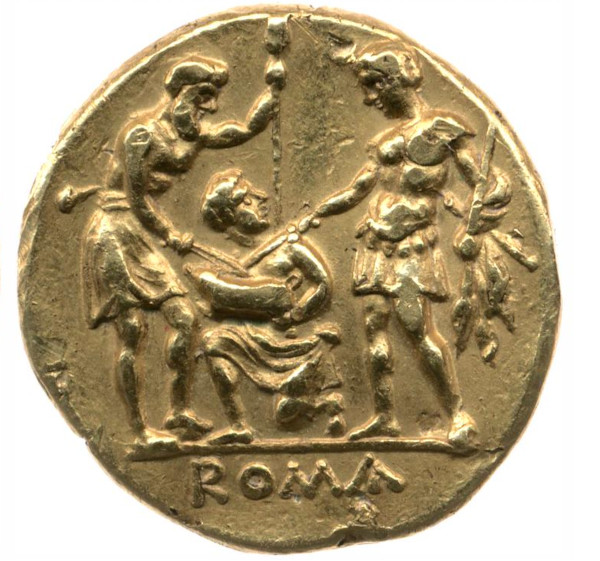
The legion was the Ancient World’s massed weapon of destruction. It was formed of professional soldiers recruited from among Roman citizens organised into nine cohorts each of six centuries of 80 men, with a tenth cohort of double size, for a total of 5,600 — closer to 6,000 men with its officers (a legate in overall command, a camp prefect, and six military tribunes, centurions, eagle standard bearer, standard bearers, and horn blowers, plus a unit of cavalry).
Discipline — enforced by its vine-staff-wielding centurions and the threat of punishment — and constant training — involving drills and erecting practice camps — made it a professional, standing army ready for war. It was self-sufficient, able to fight for a military objective, forage for food, fabricate arms and armour, and forts for protection — and, of course, construct those famously straight roads for getting its men to places ‘marching at the full step’ (24 miles in 24 hours).
The Roman army was made professional by Augustus (27BC–AD14) with funding from his own money and tax revenues. Under him, there were 28 legions — 25 after the infamous Battle of Teutoburg in Germania in AD9 — rising to 33 under Septimius Severus in the third century. The legions moved around according to the strategy of the army’s commander-in-chief, the imperator (‘emperor’). Under Tiberius Caesar (AD24), at the time of Jesus Christ, it was deployed thus:
“Italy, on both seas, was guarded by fleets, at Misenum and at Ravenna, and the contiguous coast of Gaul by ships of war captured in the victory of Actium and sent by Augustus powerfully manned to the town of Forojulium. But our chief strength was on the Rhine, as a defence alike against Germans and Gauls, and numbered eight legions. Hispania, lately subjugated, was held by three…
“The rest of Africa was garrisoned by two legions, and Egypt by the same number. Next, beginning with Syria, all within the entire tract of country stretching as far as the Euphrates, was kept in restraint by four legions, and on the frontier were Iberian, Albanian, and other kings, to whom our greatness was a protection against any foreign power…
“The bank of the Danube by two legions in Pannonia, two in Moesia, and two also were stationed in Dalmatia, which, from the situation of the country, were in the rear of the other four and, should Italy suddenly require aid, not too distant to be summoned.”
Tacitus, Annals 4.5.
On show is a certificate of discharge cast in bronze (nowadays called a diploma), found in Egypt, which is dated precisely 8 September, AD79 — the day the life of Marcus Papirius, a marine with the Roman fleet at Alexandria, changed forever and he began his next chapter.
There were élite forces too:
“The capital [Rome] was garrisoned by its own special soldiery — three Urban, nine Praetorian Cohorts — levied for the most part in Etruria and Umbria, or ancient Latium and the old Roman colonies.”
Tacitus, Annals 4.5.
Non-Romans were also recruited into their own professional auxiliary units, providing infantry and cavalry with distinctive skills and tactical capabilities:
“There were besides, in commanding positions in the provinces, allied fleets, cavalry and light infantry, of but little inferior strength; but any detailed account of them would be misleading, since they moved from place to place as circumstances required, and had their numbers increased and sometimes diminished.”
Tacitus, Annals 4.5.
After service they could receive the coveted Roman citizenship, which passed to their children.
The Roman army of some 300,000 men was, thus, a diverse and international force deployed across the borders of the Roman Empire. Within many of the provinces the legions provided a local police force, its centurions adjudicating as judges in disputes between farmers and townsfolk.
Legion: life in the Roman army focuses on the experiences of ordinary soldiers and their families. The visitor sees the Roman army through the eyes of a real legionary named Claudius Terentianus from Egypt. His story is known from letters he wrote, which survive to be read today. In them Terentianus recounts his attempt to join the legions in about AD 110 — which failed.
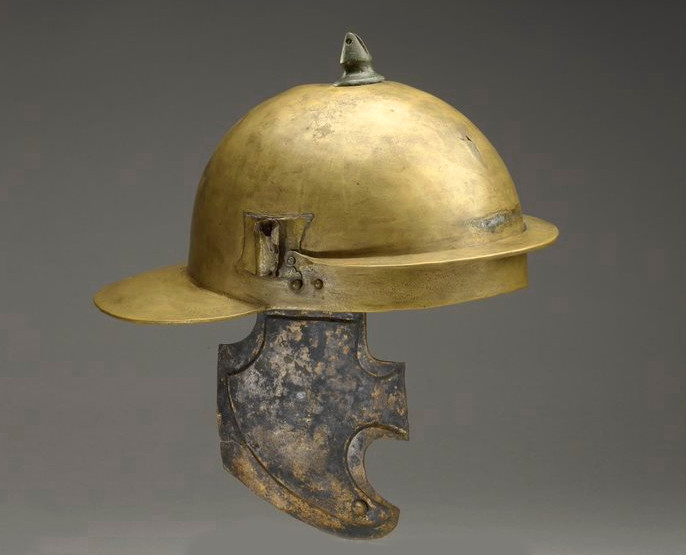
He writes home asking for clothing and equipment and reports on his struggles to fit in with the rigours of army life. Hoping for a transfer, he is deployed to the eastern front in Emperor Trajan’s ambitious war with the Parthian Empire (AD114–117). He finally succeeds in achieving his ambition. After years of service as ‘a soldier of the legion’ (as he called himself) in 136 he is honourably discharged and lives into retirement as a veteran.
For a fit, healthy teenage male like Terentianus the Roman army offered a real career — perhaps the only one at the time — with opportunities for advancement. Legionaries were often recruited from colonies (coloniae) of retired troops, with sons frequently following their fathers. The enticements were glory and the possibility of riches from war spoils.
In the meantime, serving up to 25 years, a legionary received an annual stipend in cash. There were deductions for food and a contribution to the pension bonus issued at the end of his career. A Roman soldier paid for his own equipment. Examples of Roman arms and armour are on display in the exhibition, specimens which will make any period re-enactor drool.
There are helmets of different designs made of copper alloy or iron. Some feature exquisite visors which covered the wearer’s face, likely worn by cavalrymen. From Kalkriese in Germany — a site believed to be associated with the massacre at Teutoburg — comes the oldest, most complete suit of body armour, found in 2020. Dated to AD9–16, it is a variant of the articulated, segmented plate armour nowadays called lorica segmentata (what the Romans called it is not known).
A suit of chain mail armour, its tiny links now fused together, comes from the Roman fort of Luguvallum (located within present-day Carlisle) on Hadrian’s Wall. From Melrose, at the edge of Newstead village (Trimontium) in Scotland, is the recently re-assembled arm guard (manica), modelled after the type used by gladiators, and adopted into the kit of some regular soldiers for their protection when fighting an opponent with long swords or spears.
From Dura-Europos in present day Syria comes the only complete scutum. Made of wood, the rectangular shield with its curved profile was designed to wrap around the front of the body. Conserved by Yale University Art Gallery, its intricate decoration in vivid colours reminds us that Roman soldiers were as proud and showy as any soldier of any age in history. This same trait is demonstrated in the elaborate patterns on scabbards of daggers and other personal items.
The so-called ‘Sword of Tiberius’ was sheathed in the ‘Scabbard of Tiberius’; its embossed image is inscribed in Latin, Felicitas Tiberi (‘Tiberius’ Good Luck’), while the shield held by the goddess Victory bears the legend Vic[toria] Aug[usti] (‘Augustan Victory’). It was likely commissioned by an officer who served under the command of Tiberius in the Alpine War (15BC) and wanted a way to display his association with the successful campaign.
There was no standardisation then, unlike the way modern armies now expect their troops to turn out. The Roman army on parade would present a motley mixture of styles of panoply and personalisation, perhaps the painted blazon on the scutum being the only means to identify the men as being one common unit. All Roman arms and equipment were made by craftsmen of different abilities — some of them not good.
Not all soldiers lived to retirement, like Claudius Terentianus. There are occasions in the exhibition for reflection at the ultimate sacrifice made by individual men. The soldier who wore the armour found at Kalkriese likely died in it after a bloody struggle with a Germanic warrior.
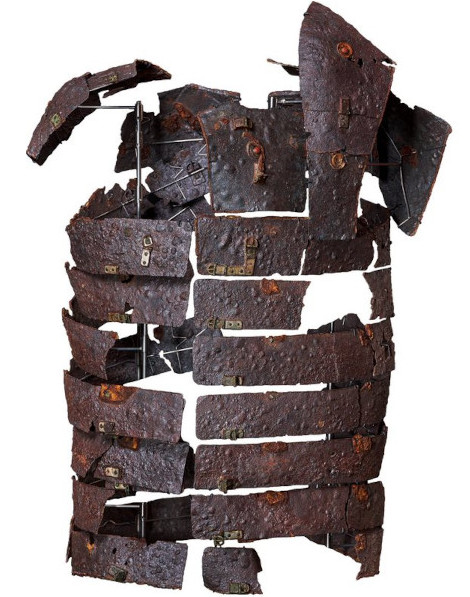
The remains of a soldier or militiaman found at Herculaneum have been reunited with his belt and equipment for the first time outside Italy; he is believed to been helping people flee the eruption of Vesuvius in AD79, but died while doing so.
For the Romans, pax — ‘peace’ (more accurately a pact) — was the desired outcome of war. After fighting, the enemy was expected to surrender unconditionally and yield to the Roman way.
In the post-war period, the presence of Roman soldiers as veterans was crucial to pacifying conquered territories. In coloniae, city-based communities modelled after Rome itself, ex-soldiers became tradesmen, shopkeepers, local politicians, husbands, and fathers. In this way ‘barbarians’ became Romanised, even if that meant blending aspects of cultural difference: the inherent adaptability of Roman civilisation could cope with that.
The exhibition features inscriptions and ephemera of these private lives filled with fun and lovemaking. Tombstones can illustrate the nuance and complexity of Roman civil and military society, and between citizen and slave. From South Shields (Arbeia) in Northern England a funeral stele (RIB 1065) reveals that Regina was the wife of the soldier Barate. She was British, a slave who had been freed, and he, a citizen, came from Palmyra in Syria. She only lived to the age of 30. His lament written in Palmyrene says all one needs to know about their relationship: “Regina, the freedwoman of Barate, alas!”
From Vindolanda in Northern England, there is a sandstone gaming board with glass gaming pieces (dated AD 85-410) and a pair of children’s shoes (of the same date range) — a reminder that soldiers fathered children, often with common-law wives, who lived outside the forts in townships.
A figurine of a mouse blowing a trumpet and covering its little ears reveals a silly sense of humour shared by its maker and owner — perhaps the pride and joy of a soldier’s son or daughter. There are altars set up by soldiers in fulfilment of vows, highlighting how religious beliefs were important to the men who fought for Rome.
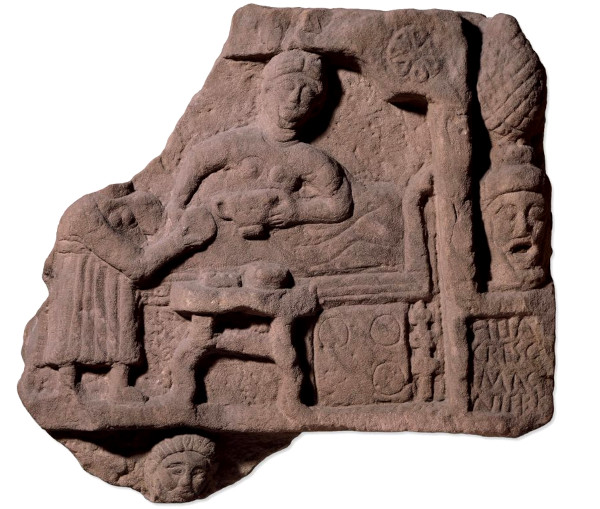
Though the legions were stationed in camps on the frontier, the world of the army was never far away from the civil. Coins in circulation celebrated the army’s achievements in war. The imperial mint communicated images and messages of victory, glory, discipline, and the loyalty of the army, as a selection of specimens at the exhibition highlights. A new emperor’s first port of call was to the camp of the Praetorian Cohorts in Rome to secure the soldiers’ loyalty with cash donatives.
In the fourth century AD, when Germanic tribes were already encroaching on the empire’s borders, one Vegetius wrote a report addressed to Emperor Valentinian II (reigned 375–392). In it, he tried to identify what made the Roman army of 300 years earlier the formidable — and highly successful — fighting force it was. He writes:
“Victory in war does not depend entirely upon numbers or mere courage; only skill and discipline will insure it. We find that the Romans owed the conquest of the world to no other cause than continual military training, exact observance of discipline in their camps, and unwearied cultivation of the other arts of war. Without these, what chance would the inconsiderable numbers of the Roman armies have had against the multitudes of the Gauls? Or with what success would their small size have been opposed to the prodigious stature of the Germans? The Iberians surpassed us not only in numbers, but in physical strength. We were always inferior to the Africans in wealth and unequal to them in deception and stratagem. And the Greeks, indisputably, were far superior to us in skill in arts and all kinds of knowledge.”
Vegetius, On Military Matters 1.1.
A visit to Legion: life in the Roman army will enable the visitor to better understand the Roman army both as force for war fighting and its complicated relationship with peace making. The exhibition is at the British Museum from 1 February to 23 June, 2024. Book your ticket!
Lindsay Powell is a historian and writer with a special interest in the combat, commanders, campaigns, and conflicts of the Ancient World. He is news editor of Ancient Warfare magazine and the author of the critically acclaimed Augustus at War: The Struggle for the Pax Augusta.
Other features by Lindsay include:
On the trail of an emperor, a rebel, and a lion
Eat, drink, and be merry the Pompeian way
And there’s a Historia Q&A with Lindsay Powell as well
For more about Roman history and the daily life of its citizens, have a look at:
Why the Roman Empire grew so big and The dark legacy of Rome by Harry Sidebottom
Agricola’s victories in Britain and Domitian, an unlikely emperor by Simon Turney
How Roman was Roman Britain? by Jacquie Rogers
Vanity project or lasting legacy – was Hadrian’s Wall worth all the effort? by Douglas Jackson
Roman Andalusia by Alistair Tosh
Sex in Ancient Rome, Gladiator sweat and leech hair dye; how to survive in Ancient Rome and How (not) to become a Roman Emperor by LJ Trafford
She Wolves, Night Moths and Tomb Whores by Elizabeth Storrs
Anthony Riches asks Did Roman Soldiers Suffer PTSD?
Ovid the policeman by Fiona Forsyth
Images, all provided by the British Museum:
- Gilded bronze scabbard for the Sword of Tiberius 1866,0806.1
- Gold coin — oath-taking scene between two soldiers: © The Trustees of the British Museum
- Conservator Bethan Bryan with the brass Roman arm guard: © Duncan McGlynn, National Museums Scotland
- Copper alloy Roman legionary helmet: © The Trustees of the British Museum
- Roman scutum (shield): Yale University Art Gallery, Yale-French Excavations at Dura-Europos
- Armour from the Arminius revolt: Museum und Park Kalkriese
- Tombstone of an imaginifer’s daughter, AD100–300: © The Trustees of the British Museum

